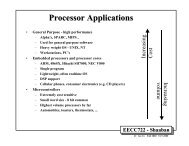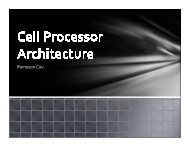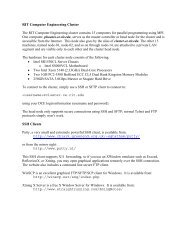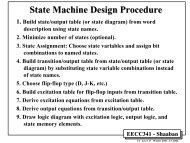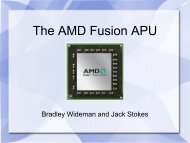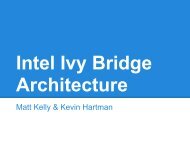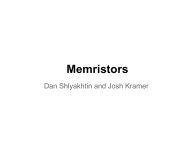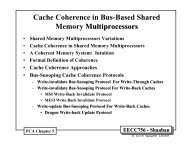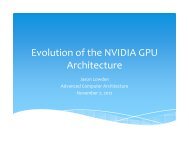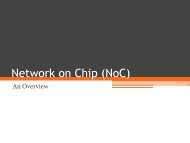EECC250 - Shaaban
EECC250 - Shaaban
EECC250 - Shaaban
Create successful ePaper yourself
Turn your PDF publications into a flip-book with our unique Google optimized e-Paper software.
Intel 80x86 Register Organization<br />
32-bit registers not present in 8086, 8088, or 80286<br />
<strong>EECC250</strong> - <strong>Shaaban</strong><br />
#1 lec #19 Winter99 2-3-2000
80386/80486/Pentium Registers<br />
32 bits<br />
The ax, bx, cx, dx, si, di, bp, sp, flags, and ip<br />
registers of the 8068 were all extended to 32 bits.<br />
The 80386 calls these new 32 bit versions EAX,<br />
EBX, ECX, EDX, ESI, EDI, EBP, ESP,<br />
EFLAGS, and EIP<br />
Memory segments can be as large as 4GB<br />
<strong>EECC250</strong> - <strong>Shaaban</strong><br />
#2 lec #19 Winter99 2-3-2000
80x86 Flag Settings<br />
ZF Zero Flag 1:ZR:Zero 1 indicates that the result was zero<br />
0:NZ:Non-zero<br />
CF Carry Flag 1:CY Unsigned math and shifting<br />
0:NC Needed a carry or borrow.<br />
OF Overflow Flag 1:OV<br />
0:NV<br />
SF Sign Flag 1:NG:- MSB of result<br />
0:PL:+<br />
<strong>EECC250</strong> - <strong>Shaaban</strong><br />
#3 lec #19 Winter99 2-3-2000
80x86 Register Usage<br />
80x86<br />
General Registers<br />
AX (AH,AL): Accumulator, Math operations (General Purpose)<br />
BX (BH,BL): Address/Pointer<br />
CX(CH,CL): Counting & Looping<br />
DX(DH,DL): Data, Most Significant bytes of a 16-bit MUL/DIV<br />
Index Registers<br />
SP: Stack pointer<br />
BP: Base pointer Stack operations: parameters of a subroutine<br />
SI: Source Index (arrays & strings)<br />
DI: Destination Index (arrays & strings)<br />
Segment Registers<br />
CS: Code Segment: Used with Instruction Pointer (IP) to fetch instructions<br />
DS: Default (Data) Segment: Variables<br />
SS: Stack Segment: Subroutines & local variables in procedures<br />
ES: Extra Segment: String operations<br />
<strong>EECC250</strong> - <strong>Shaaban</strong><br />
#4 lec #19 Winter99 2-3-2000
80x86 Real Mode Memory Addressing<br />
• Real Mode 20-bit memory addressing is used by default<br />
• Memory addresses have the form: Segment:Offset<br />
4 bits<br />
Example<br />
Linear address for Segment:Offset = 2222:3333 = 25553<br />
Segment:offset address for Linear address = 25553:<br />
Several possible combinations: 2222:3333 2000:5553 etc.<br />
Both the segment and offset are 16-bit fields.<br />
Segments provide a 2 16 (64 KBytes) window<br />
into memory.<br />
To generate a linear 20-bit address from<br />
a segment:offset address:<br />
The segment is shifted left by 4 bits, and<br />
added to the offset field.<br />
On the 80386 and later, the offset can be<br />
a 16-bit constant or a 32-bit constant.<br />
<strong>EECC250</strong> - <strong>Shaaban</strong><br />
#5 lec #19 Winter99 2-3-2000
A Little 80x86 History<br />
In 1976, when Intel began designing the 8086 processor, memory was very expensive.<br />
Personal computers at the time, typically had four thousand bytes of memory. Even when<br />
IBM introduced the PC five years later, 64K was still quite a bit of memory, one megabyte<br />
was a tremendous amount.<br />
Intel's designers felt that 64K memory would remain a large amount throughout the lifetime<br />
of the 8086. The only mistake they made was completely underestimating the lifetime of the<br />
8086. They figured it would last about five years, like their earlier 8080 processor.<br />
They had plans for lots of other processors at the time, and "86" was not a suffix on the<br />
names of any of those. Intel figured they were set. Surely one megabyte would be more than<br />
enough to last until they came out with something better. Unfortunately, Intel didn't count<br />
on the IBM PC and the massive amount of software to appear for it. By 1983, it was very<br />
clear that Intel could not abandon the 80x86 architecture.<br />
They were stuck with it, but by then people were running up against the one megabyte limit<br />
of 8086. So Intel gave us the 80286. This processor could address up to 16 megabytes of<br />
memory. Surely more than enough. The only problem was that all that wonderful software<br />
written for the IBM PC (MS DOS) was written in such a way that it couldn't take advantage<br />
of any memory beyond one megabyte.<br />
<strong>EECC250</strong> - <strong>Shaaban</strong><br />
#6 lec #19 Winter99 2-3-2000
80x86 Real Mode Memory Addressing<br />
Utilization of segments:<br />
SS:<br />
Stack segment,<br />
stack area<br />
CS:<br />
Code segment,<br />
Program code<br />
DS:<br />
Default segment,<br />
Data and variables<br />
<strong>EECC250</strong> - <strong>Shaaban</strong><br />
#7 lec #19 Winter99 2-3-2000
80x86 Instruction Properties<br />
• Each instruction can only access memory once:<br />
MOV VAR1,VAR2<br />
not valid<br />
• For 2-operand instructions, size of operands must match:<br />
– Compare 8-bit number to 8-bit number<br />
– Compare 16-bit number to 16-bit number<br />
CMP AH,AX<br />
not valid<br />
• Destination operand (usually the first) must be a register or<br />
memory address:<br />
MOV 1234,AX<br />
not valid<br />
• Number storage in memory: LSB in low memory.<br />
<strong>EECC250</strong> - <strong>Shaaban</strong><br />
#8 lec #19 Winter99 2-3-2000
80x86 Addressing Modes<br />
Direct (uses default segment, DS)<br />
mov<br />
mov<br />
mov<br />
mov<br />
al, cs:[bx]<br />
al, ds:[bp]<br />
al, ss:[si]<br />
al, es:[di]<br />
Register Indirect<br />
(or Base Relative)<br />
mov<br />
mov<br />
mov<br />
mov<br />
al, [bx]<br />
al, [bp]<br />
al, [si]<br />
al, [di]<br />
<strong>EECC250</strong> - <strong>Shaaban</strong><br />
#9 lec #19 Winter99 2-3-2000
80x86 Addressing Modes<br />
mov<br />
mov<br />
mov<br />
mov<br />
al, disp[bx]<br />
al, disp[bp]<br />
al, disp[si]<br />
al, disp[di]<br />
mov<br />
mov<br />
mov<br />
mov<br />
al, ss:disp[bx]<br />
al, es:disp[bp]<br />
al, cs:disp[si]<br />
al, ss:disp[di]<br />
Indexed<br />
or Base-relative Direct<br />
Note that Intel still refers to these addressing modes as based addressing and indexed addressing.<br />
Intel's literature does not differentiate between these modes with or without the constant.<br />
There is very little consensus on the use of these terms in the 80x86 world.<br />
<strong>EECC250</strong> - <strong>Shaaban</strong><br />
#10 lec #19 Winter99 2-3-2000
80x86 Addressing Modes<br />
Based Indexed<br />
mov<br />
mov<br />
mov<br />
mov<br />
al, [bx][si]<br />
al, [bx][di]<br />
al, [bp][si]<br />
al, [bp][di]<br />
Based Indexed Plus Displacement<br />
mov<br />
mov<br />
mov<br />
mov<br />
al, disp[bx][si]<br />
al, disp[bx+di]<br />
al, [bp+si+disp]<br />
al, [bp][di][disp]<br />
<strong>EECC250</strong> - <strong>Shaaban</strong><br />
#11 lec #19 Winter99 2-3-2000
Addressing Modes Samples<br />
Register MOV AX, BX Move to AX the 16-bit value in BX<br />
Register MOV AX, DI Move to AX the 16-bit value in DI<br />
Register MOV AH, AL Move to AH the 8-bit value in AL<br />
Immediate MOV AH, 12H Move to AH the byte value 12H<br />
Immediate MOV AX, 1234H Move to AX the value 1234H<br />
Immediate MOV AX, CONST Move to AX the constant defined as<br />
CONST<br />
Immediate MOV AX, OFFSET x Move to AX the address (offset) of<br />
variable x<br />
Direct MOV AX, [1234H] Move to AX value at memory location<br />
1234H (uses default segment, DS)<br />
Direct MOV AX, x Move to AX the value of M[x]<br />
(uses default segment, DS)<br />
Direct MOV x, AX Move to M[x] the value of AX<br />
(uses default segment, DS)<br />
Register Indirect MOV AX, [DI] Move to AX the value at M[DI]<br />
(uses default segment, DS)<br />
Register indirect MOV [DI], AX Move to M[DI] the value AX<br />
(uses default segment, DS)<br />
<strong>EECC250</strong> - <strong>Shaaban</strong><br />
#12 lec #19 Winter99 2-3-2000
Addressing Modes Samples<br />
Base-relative MOV AX, [BX] Move to AX the value M[BX]<br />
(uses default segment, DS)<br />
Base-relative MOV [BX], AX Move to M[BX] the value AX<br />
(uses default segment, DS)<br />
Base-relative MOV AX, [BP] Move to AX the value of M[BP]<br />
(uses stack segment, SS)<br />
Base-relative MOV [BP], AX Move to M[BP] the value of AX<br />
(uses stack segment, SS)<br />
Base-relative Direct MOV AX, tab[BX] Move to AX the value M[tab+BX]<br />
(or indexed)<br />
(uses default segment,DS)<br />
Base-relative Direct MOV tab[BX], AX Move to M[tab+BX] the value A<br />
(or indexed)<br />
(uses default segment, DS)<br />
Based Indexed MOV AX, [BX+DI] Move to AX the value M[BX+DI]<br />
(uses default segment, DS)<br />
Based Indexed MOV [BX+DI], AX Move to M[BX+DI] the value AX<br />
(uses default segment, DS)<br />
Based Indexed Plus MOV AX, [BX+DI+1234H] Move to AX the value pointed to<br />
Displacement<br />
by BX+DI+1234H (uses DS)<br />
<strong>EECC250</strong> - <strong>Shaaban</strong><br />
#13 lec #19 Winter99 2-3-2000
80x86 Instructions<br />
• Logic Operations:<br />
NOT OR XOR AND<br />
TEST (Non-destructive AND)<br />
• Shifting/Rotate Operations:<br />
SHR : Shift Right (insert zero)<br />
SHL == SAL : Shift Left (insert zero)<br />
ROR : Rotate Right<br />
ROL : Rotate Left<br />
SAR : Shift Arithmetic Right<br />
(preserve high-bit)<br />
RCR : use 9th/17th carry flag<br />
RCL : use 9th/17th carry flag<br />
Note: Carry flag (CF) always receives the shifted-out result<br />
Note: Register CL can be used for shifts > 1 bit.<br />
<strong>EECC250</strong> - <strong>Shaaban</strong><br />
#14 lec #19 Winter99 2-3-2000
80x86 Logic & Rotates Example<br />
mov ax,3 ; Initial register values<br />
mov bx,5 ;<br />
or ax,9 ; ax
80x86 Instructions<br />
• Simple Math Operations:<br />
ADD : Add : A+=B<br />
SUB : Subtract : A-=B<br />
NEG : A=-A<br />
INC : A++ (Does not affect carry flag)<br />
DEC : A-- (Does not affect carry flag)<br />
• Compare:<br />
CMP : Same as SUB, but does not write result<br />
(only sets flags) i.e., CMP A,B performs A-B<br />
eg: CMP 5,4 performs 5-4=1 : NZ PL NC NV<br />
• Conditional jumps:<br />
• Unconditional JUMP:<br />
JE,JL,JG,JNE,etc..<br />
Short jumps (signed, 8-bit displacement).<br />
JMP<br />
Allows long displacement<br />
<strong>EECC250</strong> - <strong>Shaaban</strong><br />
#16 lec #19 Winter99 2-3-2000
Stack & Procedure Instructions<br />
• PUSH - Place element on top of stack<br />
• POP - Remove element from top of stack<br />
Example:<br />
PUSH AX ; Place AX on the stack<br />
PUSH BX ; Place BX on the stack<br />
...<br />
modify contents of Registers AX & BX<br />
…<br />
POP BX ; Restore original value of BX<br />
POP AX ; Restore original value of AX<br />
• CALL - Call a subroutine<br />
• RET - Return from a subroutine<br />
Example:<br />
PrintRec PROC NEAR<br />
...<br />
Print value of a record<br />
…<br />
RET<br />
PrintRec ENDP<br />
main PROC FAR<br />
..<br />
Calculate Scores<br />
…<br />
CALL PrintRec<br />
Continue Execution HERE<br />
…<br />
CALL DOSXIT<br />
main ENDP<br />
<strong>EECC250</strong> - <strong>Shaaban</strong><br />
#17 lec #19 Winter99 2-3-2000
68000 & 8086 Example<br />
The following two programs implement the product of two vectors X, Y<br />
of size 100. This process is described as SUM Xi*Yi for i=1 to 100.<br />
Pseudocode of this calcualtion:<br />
sum
68000 & 8086 Example<br />
The same program coded in8086 assembly:<br />
; this is 8-bit by 8-bit multiply only. TO do 16-bit by 16-bit the code<br />
; will be much more complicated.<br />
MOV AX, 2000H ; Setup the data segment register<br />
MOV DS, AX ; load the data segment base<br />
MOV CX, 100 ; index i<br />
LEA BX, P ; load X address<br />
LEA SI, Q ; Load Y address<br />
MOV DX, 0000H ; sum
Data Movement Instructions<br />
• These instructions include:<br />
– mov, xchg, lds, lea, les, lfs, lgs, lss, push, pusha, pushad,<br />
pushf, pushfd, pop, popa, popad, popf, popfd, lahf, and sahf.<br />
• The MOV Instruction:<br />
The mov instruction takes several different forms:<br />
mov<br />
mov<br />
mov<br />
mov<br />
mov<br />
mov<br />
mov<br />
mov<br />
mov<br />
mov<br />
mov<br />
reg, reg<br />
mem, reg<br />
reg, mem<br />
mem, immediate data<br />
reg, immediate data<br />
ax/al, mem<br />
mem, ax/al<br />
segreg, mem16<br />
segreg, reg16<br />
mem16, segreg<br />
reg16, segreg<br />
No memory to memory<br />
move operation<br />
<strong>EECC250</strong> - <strong>Shaaban</strong><br />
#20 lec #19 Winter99 2-3-2000
The XCHG Instruction<br />
• The xchg (exchange) instruction swaps two values. The general<br />
form is:<br />
xchg<br />
operand1, operand2<br />
• There are four specific forms of this instruction on the 80x86:<br />
xchg<br />
xchg<br />
reg, mem<br />
reg, reg<br />
xchg ax, reg16<br />
xchg eax, reg32 (Available only on 80386 and later processors)<br />
<strong>EECC250</strong> - <strong>Shaaban</strong><br />
#21 lec #19 Winter99 2-3-2000
The LEA Instruction<br />
• The lea (Load Effective Address) loads the specified 16 or 32<br />
bit general purpose register with the effective address of<br />
the specified memory location. lea takes the form:<br />
lea<br />
dest, source<br />
• The specific forms on the 80x86 are<br />
lea<br />
lea<br />
reg16, mem<br />
reg32, mem (Available only on 80386 and later processors)<br />
Examples:<br />
lea<br />
lea<br />
lea<br />
lea<br />
lea<br />
ax, [bx]<br />
bx, 3[bx]<br />
ax, 3[bx]<br />
bx, 4[bp+si]<br />
ax, -123[di]<br />
<strong>EECC250</strong> - <strong>Shaaban</strong><br />
#22 lec #19 Winter99 2-3-2000
Conversion Instructions<br />
• The 80x86 instruction set provides several conversion instructions.<br />
They include movzx, movsx, cbw, cwd, cwde, cdq, bswap, and xlat.<br />
• Most of these instructions sign or zero extend values, the last two<br />
convert between storage formats and translate values via a lookup<br />
table. These instructions take the general form:<br />
• movsx<br />
Sign extend an eight bit value to a sixteen or thirty-two bits, or sign<br />
extend a sixteen bit value to a thirty-two bits. This instruction uses a<br />
mod-reg-r/m byte to specify the two operands. The allowable forms<br />
for this instruction are<br />
movsx reg16, mem8<br />
movsx reg16, reg8<br />
movsx reg32, mem8<br />
movsx reg32, reg8<br />
movsx reg32, mem16<br />
movsx reg32, reg16<br />
<strong>EECC250</strong> - <strong>Shaaban</strong><br />
#23 lec #19 Winter99 2-3-2000
Arithmetic Instructions<br />
• The 80x86 provides many arithmetic operations: addition, subtraction,<br />
negation, multiplication, division/modulo (remainder), and comparing<br />
two values. The instructions provided are:<br />
add, adc, sub, sbb, mul, imul, div, idiv, cmp, neg, inc, dec, xadd,<br />
cmpxchg, and some miscellaneous conversion instructions: aaa, aad,<br />
aam, aas, daa, and das<br />
• The generic forms for these instructions are:<br />
add dest, src dest := dest + src<br />
adc dest, src dest := dest + src + C<br />
SUB dest, src dest := dest - src<br />
sbb dest, src dest := dest - src - C<br />
mul src acc := acc * src<br />
imul src acc := acc * src<br />
imul dest, src1, imm_src dest := src1 * imm_src<br />
imul dest, imm_src dest := dest * imm_src<br />
imul dest, src dest := dest * src<br />
div src acc := xacc /-mod src<br />
idiv src acc := xacc /-mod src<br />
cmp dest, src dest - src (and set flags)<br />
neg dest dest := - dest<br />
inc dest dest := dest + 1<br />
dec dest dest := dest - 1<br />
<strong>EECC250</strong> - <strong>Shaaban</strong><br />
#24 lec #19 Winter99 2-3-2000
The Multiplication Instructions: MUL, IMUL, AAM<br />
The multiply instructions take the following forms:<br />
Unsigned Multiplication:<br />
mul reg<br />
mul<br />
mem<br />
Signed (Integer) Multiplication:<br />
imul reg<br />
imul mem<br />
imul reg, reg, immediate 80286 and later<br />
imul reg, mem, immediate 80286 and later<br />
imul reg, immediate 80286 and later<br />
imul reg, reg 80386 and later<br />
imul reg, mem 80286 and later<br />
• The mul instruction, with an eight bit operand, multiplies the al register by the operand<br />
and stores the 16 bit result in ax.<br />
• If you specify a 16 bit operand, then mul and imul compute:<br />
dx:ax := ax * operand16<br />
• If you specify a 32 bit operand, then mul and imul compute the following:<br />
edx:eax := eax * operand32<br />
<strong>EECC250</strong> - <strong>Shaaban</strong><br />
#25 lec #19 Winter99 2-3-2000
The Division Instructions: DIV, IDIV, and AAD<br />
• The 80x86 divide instructions perform a 64/32 division (80386 and<br />
later only), a 32/16 division or a 16/8 division. These instructions take<br />
the form:<br />
div reg For unsigned division<br />
div mem<br />
idiv reg For signed division<br />
idiv mem<br />
aad ASCII adjust for division<br />
• The div instruction computes an unsigned division. If the operand is an eight<br />
bit operand, div divides the ax register by the operand leaving the quotient in<br />
al and the remainder (modulo) in ah. If the operand is a 16 bit quantity, then<br />
the div instruction divides the 32 bit quantity in dx:ax by the operand leaving<br />
the quotient in ax and the remainder in .<br />
• With 32 bit operands (on the 80386 and later) div divides the 64 bit value in<br />
edx:eax by the operand leaving the quotient in eax and the remainder in edx.<br />
<strong>EECC250</strong> - <strong>Shaaban</strong><br />
#26 lec #19 Winter99 2-3-2000



